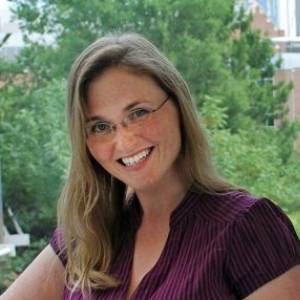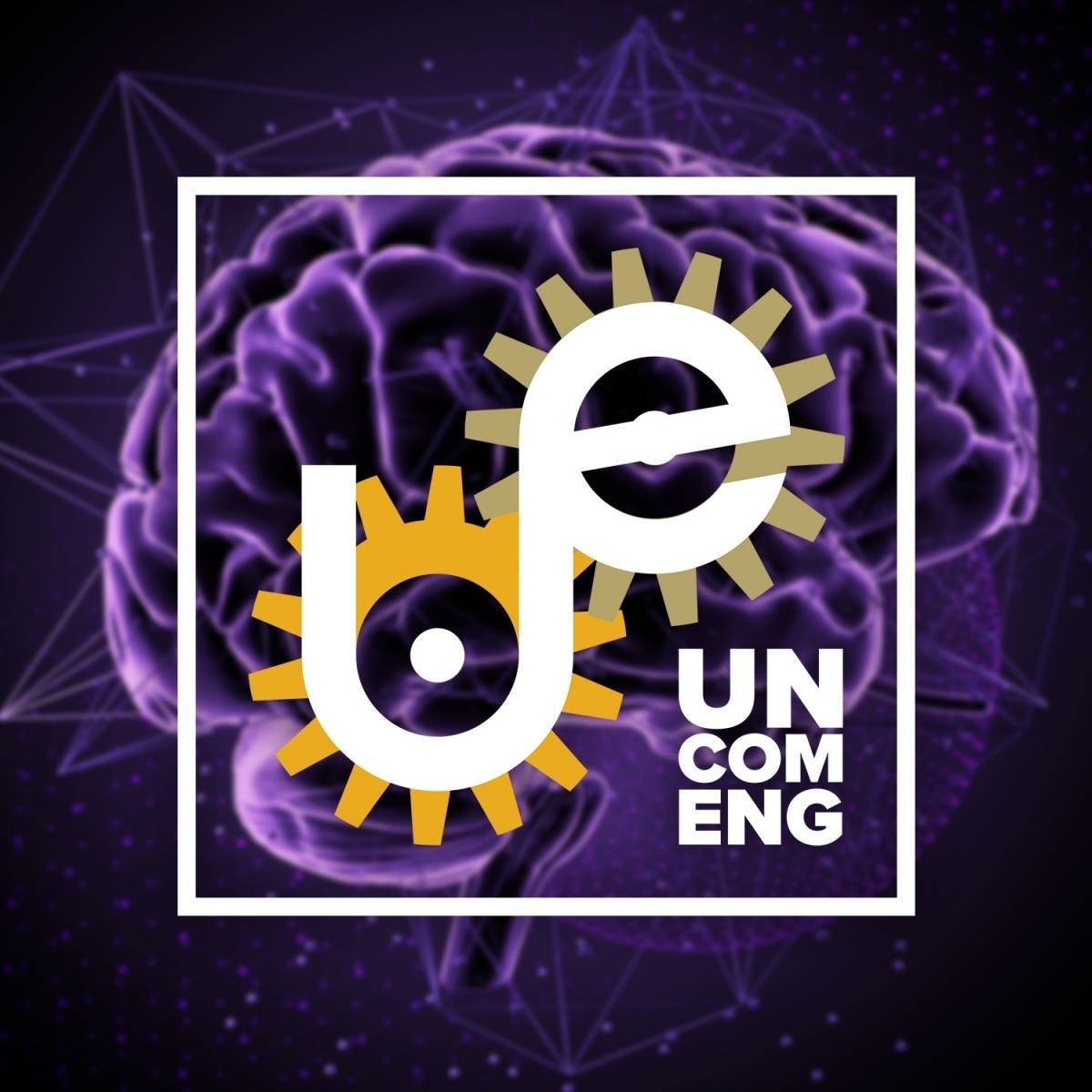Steve W. McLaughlin

Annabelle Singer

Audio
Audio & Captions
Transcript
[steam whistle]
[applause]
[big band music]
Steve McLaughlin: I’m Steve McLaughlin, dean of the Georgia Tech College of Engineering, and this is The Uncommon Engineer.
[big band music]
Male Speaker: [archival recording]— We're just absolutely pleased as punch to have you with us. Please say a few words.
[applause]
[blues music]
♪ Old memories on my mind, on my mind, on my mind ♪
Steve McLaughlin: The human brain starts creating memories as early as 20 weeks after conception. It’s really hard to believe that a baby's memories are forming while in the womb. Our memories really do make us who we are, you know, in many ways they define us which is why Alzheimer's and other diseases that affect memory are so devastating to so many people.
I’m Steve McLaughlin, dean of the Georgia Tech College of Engineering, and this is The Uncommon Engineer, our deep dive into ways Georgia Tech engineers make a difference in our world, in our daily lives, and in ways that we may not expect.
Dr. Annabelle singer does that, in part, by finding effective therapies for Alzheimer's disease. She is an assistant professor in the Coulter Department of Biomedical Engineering which is joint between Georgia Tech and Emory. In that department she is a professor and neuro engineer. Welcome to the program, Annabelle.
Annabelle Singer: Thank you.
Steve McLaughlin: Annabelle, we hear lots about Alzheimer's and, you know, the memory challenges that many people, unfortunately, have to experience. Before we talk about your research, can you talk a little bit about some of the things that are exhibited in Alzheimer’s that then your work is going to address?
Annabelle Singer: Many people have interfaced with the disease personally, and people know of it as a memory impairment. So people with advanced forms of Alzheimer's will even forget their family members. But some of the earliest signs of the disease are what we call “deficits in spatial navigation,” so people get lost in a familiar place; people have trouble finding words that they commonly use. And these are the kinds of memory impairment that we see early in the disease, and we think are signs of the neural networks, in particular the hippocampus and related structures, going wrong early in the disease.
We think that what's going wrong is several levels. So on the one hand, there are these proteins called “amyloid beta” that accumulate. And on the other hand, the connections between neurons are failing, they degrade, and that means neurons can't communicate; they can't encode information properly. And on another hand, we also think that the machinery in the brain that clears out pathogens like these proteins is also failing. So there are several different levels at which things seem to be going wrong. It's not entirely clear at this point which one of those things is the key or if it's all three or if one person with Alzheimer's has one thing going on, and a different person with Alzheimer's has one of the other things going on; they might all be playing a role in different ways.
Steve McLaughlin: I know we're going to talk about kind of how engineering overlaps with that, but your kind of identifying several different properties that then, as an engineer or as a scientist, you would try to both better understand, gather information about it, and take what the doctors have learned and then develop your own, maybe, therapies?
Annabelle Singer: We are trying to understand how neural activity fails in Alzheimer's, and typically in animal models of Alzheimer's disease because we can control them and manipulate them significantly more than in human patients. And people have long-studied Alzheimer's from the point of view of proteins that accumulate but, over the past few years, it's become more and more obvious that it's not just protein accumulation that's going on—there seems to be things that are going wrong with how neurons talk to each other, how neurons encode information, and all of that plays a role in how we end up with memory impairment. It also, really surprisingly, seems to play a role in protein accumulation itself. So this amyloid beta that forms plaques, we're now finding we can manipulate that by manipulating neural activity.
The engineering part—you know engineering plays several key roles in our research. First, at a most fundamental level, engineering is a key part of how we think about how the brain works. We think about, when we're trying to understand memory, we're trying to understand how the brain encodes information, how it stores that information, and how it recalls that information. And that kind of information processing is really heavily informed by engineering in terms of the brain is in many ways an electrical organ. It's also a chemical organ, so that information is encoded with electrical signals. Sometimes we think of them as 0’s and 1’s—it's actually not quite that simple, but that's a key way that we think about the brain.
We also use engineering in a lot of the methods that we use. So we use extensive data analysis. We write code to analyze a vast array of data that we get. We do a lot of signal processing, machine learning, things like that. We build devices to manipulate brain activity to record brain activity. So it plays a role at several different levels.
[blues music]
Steve McLaughlin: So can you say a little bit about why the brain is so hard to understand, and why we are so slow to find effective therapies for some of these neurological conditions?
Annabelle Singer: I think, at the most fundamental level, the brain is hard to understand because it's complicated. There are about 100 billion neurons in the brain—in the human brain—about 100 billion glia, which is another cell type in the brain. And each one of those neurons can have several thousand synapses; those are connections between neurons, which we think there's probably about a quadrillion of these connections between neurons. So that, you know, is a very complicated organ. It's also very diverse. We don't even at this point have a, what I would call a “parts list” of the brain; we don't know in excruciating detail what all the different cell types are, what all the different proteins are. and the other level of complexity is that it functions on many different levels from the DNA and RNA to cells, to cells communicating together in networks, to you know, the brain interfacing with the rest of the body. So all of those different levels are complicated, and we don't really have good ways to understand how we go all the way from these high levels of organ interacting with the body, all the way down to through the neural networks to DNA.
Steve McLaughlin: Unbelievably complicated and complex. And then, for folks like yourself, to try to then develop therapies or to try to better understand then move towards those therapies, just extremely complex. So I'd like to move towards your own research. And first of all, how did you get interested in doing research in Alzheimer's?
Annabelle Singer: Initially it grew out of my interest in learning and memory. I had long been interested in learning and memory. I used to think that the brain or, rather, we as people, were infinitely plastic; we could adapt to anything. And the more I learned about diseases, the more I discovered that there are limits to how plastic we are to what we can adapt to. And Alzheimer's disease is a really great example of how the learning circuits and learning capacity fails.
I also had some really great experiences in graduate school. I was at UCSF Memory and Aging Center. There, it was really wonderful in that they would let me come and observe them working with patients, diagnosing patients. And it was a really transformative experience for me. It's one thing to read about a disease; it's another thing to see patients dealing with the disease, see their families. And so that was a moving experience for me.
The last part, actually, I didn't really come to start studying Alzheimer's disease until the way that we've been thinking about the disease has changed. People used to focus a lot on the proteins that accumulate, which is not really the way that I think about the brain; I think about the brain as this electrical organ that stores information. And more recently, people like myself and a few others have been putting forward that really we need to be thinking about these electrical signals and how they're going wrong in the disease. And then in our own research we found manipulating these electrical signals actually has an effect on these proteins that accumulate. So that really changed the game for me that suddenly the way that I think about the brain, really jived with what might be going on at a fundamental level with this disease.
Steve McLaughlin: I think a lot of people who maybe came into the middle of this conversation thinking it’s like, well, two doctors talking to each other, but it's not; you're in engineering. Being an engineer, you're doing something different, and I'd like to think it’s because you're an engineer. Can you talk about why being an engineer is so important to the work you're doing?
Annabelle Singer: You know, and an engineer can really be whatever you want it to be; it's not limited. And that's one of the things I like about being at Georgia Tech; people don't seem to have a limited view of what engineering is. To me, it's really about working on practical problems, and I would say taking kind of maybe esoteric or pie-in-the-sky questions and ideas and problems, and then turning them into a really practical set of things you can do, whether that's a thing you can build or an experiment you can do to answer that question. And that, to me, is one thing I love to do, and I think that the key part of engineering is that practical application.
[music]
Steve McLaughlin: How did you find your way to being an engineer?
Annabelle Singer: My path is kind of convoluted. So I grew up in a small town. We didn't have like robotics teams and things like that. We had a theater. so I like building things; I did a lot of technical theater. I think that was probably the first place where I learned to build things and problem solve in this very practical way, and I loved it. But I ended up doing my Ph.D. in neuroscience; it’s not engineering. and it wasn't until my postdoctoral work that I worked in a neuro engineering lab. The reality is, because I had this background building things, I knew how to make circuits, you know, et cetera. It's always been a part of what I've done. I've always been comfortable doing math and writing code—well, not always—I learned how to do those things, but it's been it's been a long-term part of my career. It wasn't until the end of my Ph.D. where I realized I really wanted to be able to build my own tools; it's a key part of my research. To answer the questions I wanted to answer, I had to be able to build new tools. And I had been doing that on the side, but I wanted to be in a lab where that was the focus. And so that was that was my postdoc. And then, you know, I would say sometimes I call myself a scientist; sometimes I call myself an engineer. I think that I'm both things. I don't really think that there's necessarily an easy way to put a dividing line between the two.
Steve McLaughlin: How are you moving towards human patients? Can you say a little bit about that?
Annabelle Singer: Yes. So there's two key things we had to do to be able to move to human patients. One is develop noninvasive ways to drive this neural activity, this electrical activity, and we've done that at this point. And then the other is developing noninvasive readouts, so we're working on that as well. And we have a study that we're going to start shortly with the Emory Brain Health Center, where we'll be trying out driving this kind of activity in human patients with early stages of Alzheimer's disease and seeing if it does have similar effects as we've observed in mice.
Steve McLaughlin: So when you say a noninvasive way of getting that signal into a human patient, how would you do that?
Annabelle Singer: We're using set forms of sensory stimulation at different frequencies. And there's been decades of research that shows if you drive flickering lights or sounds trains of tones at different frequencies, you can get those same frequencies in what we call “sensory brain regions,” so parts of a cortex. And what we found that was quite surprising is that you can also do that and drive activity in much deeper brain regions—so regions that are essential for episodic memory or memories of experiences like the hippocampus, regions that are essential for what we call “executive function,” planning, like the prefrontal cortex. So that was a big surprise. And so now we are trying that in humans. And we'll see if it has the same effect, but it's an incredibly simple manipulation in the end.
Steve McLaughlin: I have experienced being somewhere in the lights like you said, the lights flickering resulted in a migraine or something lie that. You're saying that same thing, so whether you put on a headphone or you flicker the lights in a way that maybe even the patient doesn't recognize it, that signal will find its way magically to the spot for which you are applying this therapy. That doesn't sound painful at all, not invasive at all. Just sounds like, you know, like you said, I think you said it could be done through sound—put on a pair of headphones, put some sound in the right way, and that sound will make its way to the right part of the brain. Just like my headache was caused by the flickering lights, it can have a therapeutic. Do I have that right?
Annabelle Singer: Yes, you have that right.
Steve McLaughlin: That is so cool.
Annabelle Singer: It's totally noninvasive. The key part is the frequency. So the flickering lights you've probably experienced before are probably a slow frequency. And they may even have bad consequences we don't fully—we haven't fully characterized every frequency yet. But the frequencies that we have been finding have beneficial effects are about 40 hertz, which is pretty fast. For lights, it's just barely—you can see it but, but if you went to 60 hertz, you can't see it anymore. And it's true, some people might like it; some people might hate it as an experience, so one of things we'll be doing in the future is figuring out how to make it so it's not just therapeutic but enjoyable.
Steve McLaughlin: I think the public sees kind of so little advance or success in the treatment of Alzheimer's and there's so many families that are experiencing that, are you seeing the results that are hopeful? You know, this sounds like totally new approach to doing that. Can you say where's this headed? I mean it sounds really, really hopeful.
Annabelle Singer: Yes, it is a totally new approach. And it's—we're trying to translate it from mice to humans as quickly as possible; we feel that urgency from that community. The tricky part is that to really prove this has a beneficial effect in humans, is going to require, ultimately, some large, multi-center clinical trials. So our first studies are going to be small. There's still a lot of questions that we need to address in terms of figuring out how, even if it does readily translate from mice to humans, how to make it work in humans the absolute best way we can is really a big question. There's going to be several more years of research. The upside for us is it is noninvasive, so that makes it easier to make this leap from mice to humans. If it was an invasive approach or we thought it had some significant side effects, it would take us much longer.
[blues music]
Steve McLaughlin: In short, how would you describe yourself in terms of being an uncommon engineer? What does that mean for you?
Annabelle Singer: Yeah, what does that mean? I mean I feel like you just summed it up really well which is, you know, just working on being inspired by the problem and doing whatever it takes to get there. You know, sometimes that is building my own tools; sometimes that is working with clinicians, you know, to have access to patients and get new tools and new approaches into those patients. To me, I guess I'm an uncommon engineer in that my research and my work is very interdisciplinary; it doesn't take from just one discipline or one approach, and we just have to figure it out as we go to figure out how to put all these different parts together.
Steve McLaughlin: And so what kind of—yeah, I mean everything, we've talked about just exudes the need for our interdisciplinarity, people with all kinds of skills, all kinds of perspectives and backgrounds. And can you say a little bit about the kinds of students that come in and work in your lab and where they come from or what their backgrounds are?
Annabelle Singer: Yeah. So people come to my lab from many different backgrounds. I have students who are in biomedical engineering and students who are in the neuroscience program at Emory, and a postdoc who comes from a math background. So my students come from backgrounds—some might have a neuroscience undergrad; some might have chemical engineering; they might have electrical engineering, math, et cetera. And I tell them at the outset, nobody comes in knowing everything they need to know to do the work we do, and they have to be able to work together; it's a key part of my lab culture. I try, at least, for it to be a key part of lab culture, that people come—you come with your own expertise, and you exchange that knowledge because there's no way you can do it with just one part.
Steve McLaughlin: We talked a little bit about your research group and the kinds of students that might come into your group. Can you say a little bit about it? Give maybe one example of if a student came to you and said, “Hey, I want to work in your lab.” What would they do?
Annabelle Singer: Yeah. So they do a wide variety of things. Some of the undergrads in my lab, I mentioned before, building these devices that we use to drive neural activity as well as read out neural activity, so some of these devices that we use to recruit these immune cells and clear pathogens from the brain, and we've been really we've had really great success with undergrads in the lab working on that. My graduate students—so went two of my graduate students are doing a lot of the groundwork on these mouse studies to figure out what are the effects of driving these different frequencies, both on neural circuits and on the immune system, and that's directly feeding into the human research that we're planning to do.
Steve McLaughlin: What a fantastic experience that would be for our students. And so for the students out there, anybody who has a—I'm sorry I'm making an ad for encouraging all the students to show up at your door—but this sounds really fantastic opportunity.
Dr. Singer, we're so happy that you were here today, and we're really grateful to have folks like you, you know, here at Georgia Tech really making a difference for patients in uncommon ways. But we're really, really lucky to have folks like yourself on our campus. Thank you so much for coming today.
Anabelle Singer: Thank you for having me. It's been great.
Steve McLaughlin: Well that's it for The Uncommon Engineer this time. Next time, we'll shift from our inner biology to outer space, or at least our stellar neighborhood. Professor Brian Gunter comes to us to talk about space exploration and what it means for our species. Absolutely, this is one you won't want to miss.
For now, I'm Steve McLaughlin. Thanks for listening to The Uncommon Engineer.
[blues music]
♪ Old memories on my mind, on my mind, on my mind, and I promise to do no wrong ♪
[marching band music]
Geekout
Audio & Captions
Transcript
[radio dial scanning, static]
Steve McLaughlin: I’m Steve McLaughlin, dean of the Georgia Tech College of Engineering, and this is The Uncommon Engineer.
[radio dial scanning] [interposed voices]
[big band music]
Steve McLaughlin: It sounds incredibly complex—it sounds like—to build these that span—I’m really geeking out here.
[laughter and applause]
[big band music]
[psychedelic music]
So you just mentioned developing your own tools. Can you say a little bit about what those tools are?
Annabelle Singer: One of the key tools that we use in our research is a way to record neural activity from mice as they're doing a behavior. So this is some tools—basically this grew out of I was trying to do these experiments as a postdoc in freely moving mice, and it kept failing, and it was really, really significantly challenging. And so what we ended up doing was we developed this virtual reality system where mice run through a kind of virtual reality environment; they’re head-fixed, they run on this spherical treadmill, and it projects their—the way that they run changes the environment that's projected around them. And this makes it a lot easier to do these experiments in mice because they're head-fixed, so we can use basically enormous equipment to record and manipulate neural activity whereas if the animal’s freely moving, we have to shrink it down. And trying to shrink it down something for a mouse to carry is not trivial. It's very limiting in terms of what you can do.
And so that really opened up a whole world to me in terms of the kinds of experiments that I could do. And it was important that we could do this in mice because mice are the primary animal model of most human diseases. So if I wanted to study Alzheimer's disease, I needed to be able to do it in mice. If I want to study another disease, basically mice are that animal that I'm going to have to work with.
Steve McLaughlin: So let me see if I have this right. I had this visual of the mice with these VR goggles on, and I thought, you know, oh come on you got to be kidding me. But you've created a tool where the mice are like in a VR room and you project your—they're having a certain experience, and then you can record they’re freely moving, and you can record their neural signals.
Annabelle Singer: Exactly. So they are there on this treadmill that can move in any direction—so it's not just forward and back. And then that around them is a screen and we're projecting an environment on that screen. And so as they move, that environment looks like—it looks like they're moving through the environment. And then they treat it like a maze. So we have some run through mazes; they get little rewards—condensed milk—if they get to the right part of the maze, and they have to remember where they got the reward, and they to go back later and things like that.
Steve McLaughlin: And then, so that's for like for recording the neural activity, but then we talked about getting a therapy either through light or through sound. Are you doing that, too?
Annabelle Singer: Yes. So that is these flickering lights and sound we build in-house. It's actually quite simple. We have undergrads now in the lab building these devices. And so we flick our lights and sound at different frequencies to the mice and also to humans, and we do you know different combinations, different duty cycles, different signaling, shapes and things like that.
Steve McLaughlin: But you hear a lot about the use of mice, you know, to mimic humans. Again, just for at a high level, what's transferable between animals and humans, and do you learn like 50 percent of what you need from the mouse and then, boy, a bunch of it changes? Or I'm sure the answer is “It depends,” but can you talk about, you know, taking what it is you've learned from mice and moving it to humans and maybe, in particular, as it relates to Alzheimer's?
Annabelle Singer: Yeah. So that's actually a very complicated topic. I think the answer is we don't know yet, really, under what conditions does something that works in mice also work in humans. We only know when we do it and when we try it and see what translates. And so there are many things that have worked in mice that haven't worked in humans, and there's some things that do. So at a fundamental level in terms of what do we know about the brains, well, a lot of the cell types are very similar between mice and humans; a lot of the circuitry is quite similar. Actually some behaviors that mice are better at than we are—something called dead reckoning—so spatial navigation, they're better at generally than humans are. Their brain volume that's dedicated to spatial navigation is larger percentage-wise than in humans. But exactly how a drug or therapy will affect a mouse and then a human, it's not easy to predict. I do still think that mice are better models. So other models that we use for testing out new therapies are usually cells in a dish. The living brain is a better model—even if it's a mouse—than cells in a dish. Especially for the kinds of work we're doing, we can't do it in a dish, unfortunately.
[psychedelic music]
Steve McLaughlin: The idea of you expending your time and energy on mice gives you some confidence. It may not be 100 percent transferable, but it does give you a certain level of confidence based on past experience how other experiments and other parts of the neural system transfer over. Do I kind of have that right?
Annabelle Singer: Yes, I think that's right. I think, you know, like you said it depends on exactly what kinds of things you're doing, but the cell types that we think are key to our effects in mice are also the same cell types that exist in humans. So for that reason, I'm doubtful that it's going to work the same way in humans but, until I try it, I won't know for sure.
Steve McLaughlin: Yeah, good. And I know that the process for beginning the human trials that you talked about, you know, getting them going in humans is a complex thing. Again, something that engineers—people don't often associate engineers as having, you know, providing therapies directly to patients, and you're doing that. Is that an arduous process? I know we're working with Emory and, you know, they have lots and lots of experience and maybe it's arduous to begin with and, you know, maybe frustrating because you really want to try these experiments.
Annabelle Singer: Yeah. There's a lot of bureaucracy involved in doing any human study, but even more if it's a patient and even more if it's what's called an “intervention” where you're giving them something; you're not just observing but you're manipulating something like you're giving them a therapy. So there is a lot of oversight. I think, you know, that's for good reason; they don't want patients to get abused, but it does mean sometimes it does take a long time to get these studies going. And it's especially frustrating when it's not just you want to know what the results are, but what if this would be helpful to patients, you know, can't we move as fast as possible? We certainly have a lot of people who really would like to see new Alzheimer's therapies, who'd like to see that research—not just ours, but all research in this area—move as fast as possible.
Steve McLaughlin: I'm an electrical engineer, so you start talking about electrical signals and 0’s and 1’s and neurons firing, and I get all excited because I'd love to hear you say a little bit more, you know, for folks that maybe do understand electronics or electrical signals. Can you say a little bit more about your research, and what that therapy might look like from the purely electrical standpoint?
Annabelle Singer: So neurons are special. They're different from other cells in the brain in that they are electrical. So they have electrical properties. They can fire what we call “action potentials” which is—it's really an amazing phenomenon; I won't get into all the details of it, but they can generate this electrical signal, propagate it over, you know, centimeters even, and that will send then a chemical signal to another neuron which can then generate its own electrical signal. And exactly under what conditions a neuron generates that action potential is a key part of how the brain functions. So it seems that neurons take in these chemical signals from many, many other cells. Then, if those signals are strong enough, they generate their own electrical signal and propagate it downstream. And exactly what it propagates is really, we think, the key information. So if it sends one action potential or 25, and whether it's one neuron that sends the action potential or 100,000 out, we think that sends different information downstream. So you get, say, a sensory signal, you see something, that opens up channels in your retina that sends electrical signals to another set of neurons, and those keep propagating all the way through your brain until you decide what to do with that information.
Steve McLaughlin: And so then, let's say, someone who has Alzheimer’s, you know, through these plaques or through these other these other impairments, that's how the electrical signal is generated and then how it propagates from stage to stage to stage obviously is going to be different for those. And so from an electrical standpoint or, you know, what would you do to try to overcome that, say, from like as an intervention from the outside? What would you try to do?
Annabelle Singer: Yeah. I think there's actually two parts to that. First, we have to better understand what's going wrong with these electrical signals in the Alzheimer's brain, and that's still, I think, that field is in its infancy; we're working on it. But then we now have neuro modulation tools, some being developed in my own lab but others that are out in the field where we can drive these electrical signals in the brain; you can pass currents; this is going on in humans right now. You can pass currents across the brain either evasively or noninvasively and drive this neural activity. So if we can understand what's going wrong, we can then try to rescue that activity electrically.
Steve McLaughlin: And so when you talk about the signals that, you know, you have the ability to put those signals in the right place at the right time to either change how the neurons are firing or to, maybe, if there's damage caused by some of these proteins, you have the ability to change how the signal is sent. Is that right? I mean you're doing something from the outside and changing that. Can you say a little more about that? I'm sorry; I'm really geeking out here.
Annabelle Singer: No, no, it's great! So driving the neural activity, we think, in my lab we think, has two potential effects, and we have evidence for these. So on one level, when we drive electrical neural activity, we think we can change the information that's being encoded. We think we can change the way neurons communicate with each other, and there's some evidence for that at this point both in my own lab and with other people's research. That is really key way that people have thought about the brain for a long time—these electrical signals carry information. What has been a little bit more surprising is that we can drive these electrical signals. If we drive the right signal in the right way, we can also affect these these proteins that accumulate, and we do that by affecting immune cells in the brain that come and clear out proteins. So that was a big surprise—that these electrical signals, if we if you drive them in the right way, would also recruit immune cells in the brain to do their job.
Steve McLaughlin: OK. That I think I understand, you know, put it put a signal, those signals drive the immune response, and your immune response is then what then would go towards these proteins to inhibit the collection of these plaques or these proteins that then inhibit that. Did I get that right?
Annabelle Singer: Yes, that’s correct.
Steve McLaughlin: That's really, really cool.
Annabelle Singer: Yes. And, you know, right now we've come up with—they’re some ways we can do it noninvasively. We know the right frequencies, basically the frequency seems to be key. And some of the things we're doing going forward is trying to figure out what's the best way to drive these signals; what's the most comfortable way for somebody; what could actually turn it into a real therapy that humans can use.
[psychedelic music]
[blues music]
[marching band music]






